1964 United States Grand Prix race report: Hill capitalises on Clark's calamity
Victory slips from Jim Clark's grasp as more Lotus gremlins hand the win to BRM's Graham Hill; Englishman now leads the championship with one race to go
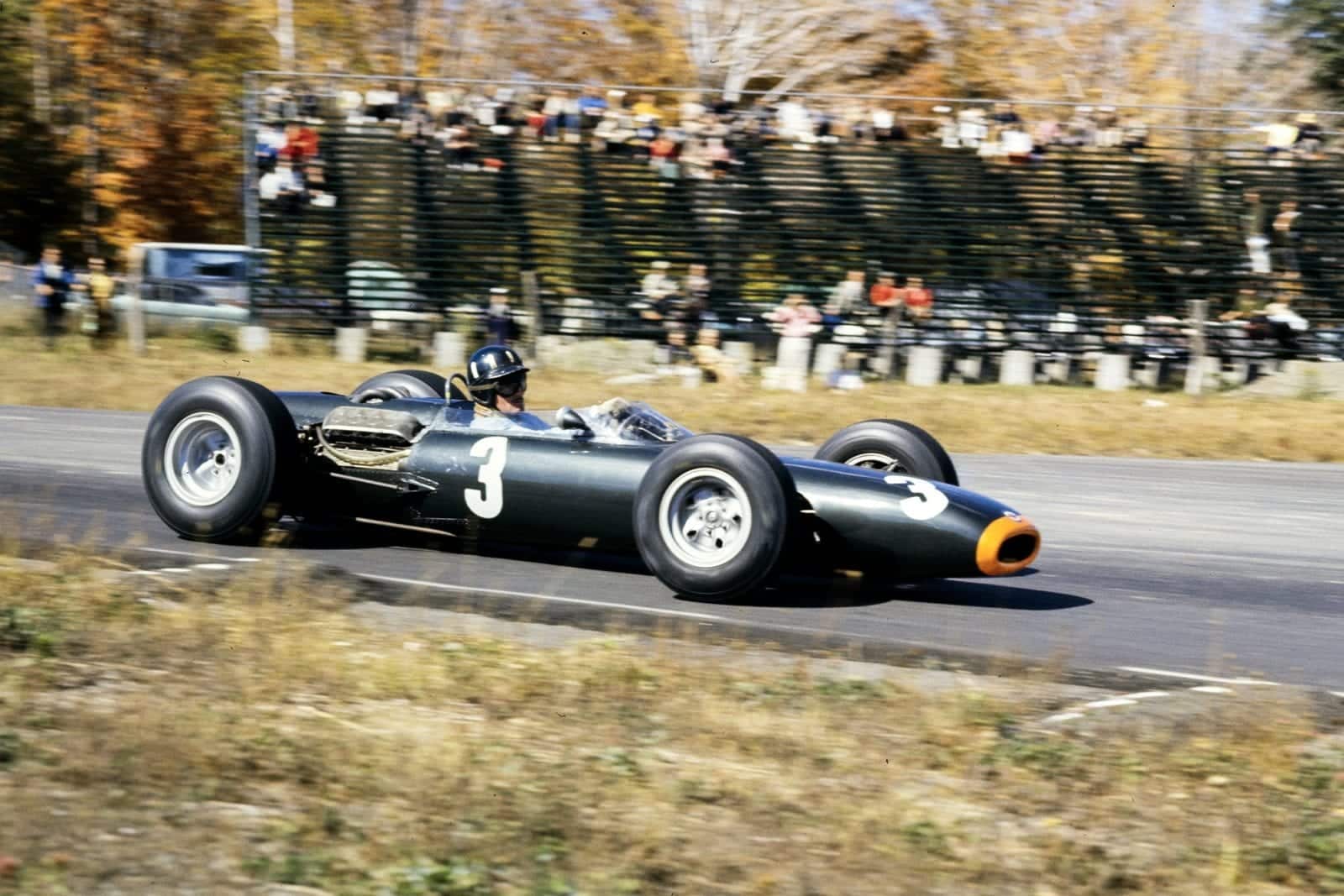
BRM's Graham Hill took his second win of the season at Watkins Glen
Motorsport Images
Watkins Glen was once again the venue for the US Grand Prix, the ninth in the 1964 World Championship series. In this, one of the most beautiful settings for any Grand Prix, the sixth United States Grand Prix was scheduled for October 4th.
Last year the World Drivers’ and Constructors’ Championships were settled by the time the Grand Prix circus had flown to the USA; this year, however, it was a different matter and certain drivers were more worried about losing points than trying all out as they did last year.
Twenty cars were to have been invited and although the third BRM was available for AJ Foyt he decided not to take part. The other nineteen cars and drivers were all present for the first practice on Friday. Brabham had two cars for himself and Gurney, the new car as raced at Monza for Jack and the older car which Gurney has driven for so long. BRM had three cars for Graham Hill and Ginther. The new car which broke on the line at Monza was for Hill while another car with new engine was for Ginther, the engineers had not found enough time to prepare a completely new car so adapted an older monocoque. The third BRM was an old car with the old engine which was for Hill to use as a training car.
Lotus arrived with three cars for Clark, Spence and American driver Walt Hansgen. Clark had the old car which he first drove in South Africa in 1962 when a small bolt lost him the Championship for 1962. The other two cars were the 33s used at Monza. Clark felt that the older car would be more suitable on this 3.7-kilometre circuit than the newer cars.
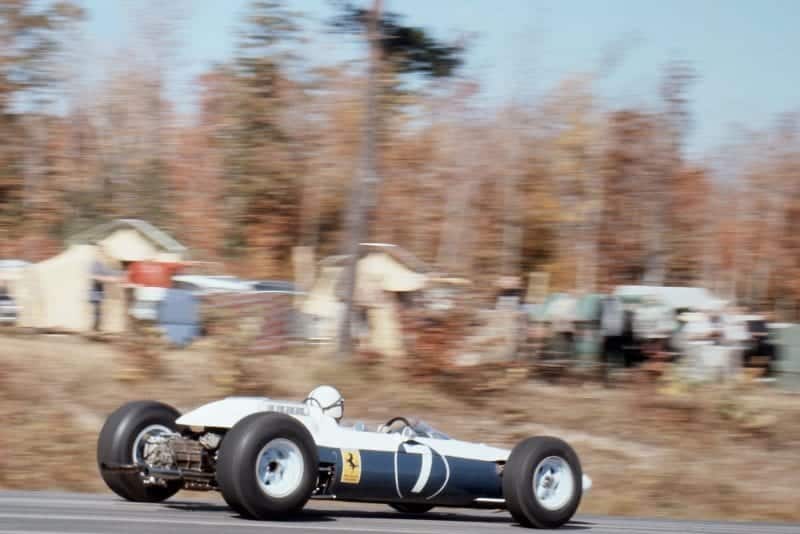
John Surtees’ Ferrari ran in the colours of the “North American Racing Team”
Motorsport Images
The Cooper team were here with their two cars and, once again, McLaren had Phil Hill as his No 2 driver, the differences which kept Hill from the Italian Grand Prix having been patched up by this time. Since the Italian GP adjustable shock-absorbers had been fitted and slight alterations had been made to the rear suspension geometry.
The Ferrari team were there in force; they had two V8 cars for Surtees and the new flat-twelve for Bandini with a V6 for the Italian as a spare. The great surprise as far as this famous Italian firm were concerned was that all the cars were painted blue and white, the colours of the USA, and were entered by the North American Racing Team. The reason for this surprising situation can be found in the statement made by Enzo Ferrari at Monza, where he said that he would never race on Italian soil again and handed in his Competitions licence.
“The great surprise as far as Ferrari were concerned was that all the cars were painted blue and white and were entered by the North American Racing Team”
Rob Walker had three cars, his Brabham-BRM for Hap Sharp, the American driver who normally drives Chaparall sports cars, the ex-Brabham car with Climax engine for Bonnier and painted Walker blue, and also entered by him was Siffert’s Brabham-BRM to be driven by its owner, Jo Siffert, The Parnell team brought two Lotus-BRMs for Amon and Hailwood, Amon’s being the car Hailwood drove at Monza and Hailwood was to drive the car he put into the lake at Enna, and which had now been rebuilt.
BRP had two cars for Ireland and Taylor. Ireland had his Monza car with new strengthened mounting points on the monocoque for the lower rear radius arms, while Taylor’s car was the one he crashed at Brands Hatch before the British GT. This was rebuilt with stronger radius arm mounting points, but as two different mechanics had made up the brackets they were both very different, but did the same job. Last, but by no means least, came the Honda V12. This was virtually as ravced at Monza but a new nose was keeping temperatures down by 10°C, and the brakes had been improved. Although not right by a very long way, Bucknum was happier than he had been in Italy.
Qualifying
So the nineteen cars were ready to start practice as soon as the track was opened. Since last year the whole track has been completely re-laid with a smooth but good-grip surface, which the organisers were optimistically hoping would considerably speed up the lap times. When the track was opened, Clark was off like a shot. The Lotus driver is the holder of the lap record of 1min 14.5sec, while G Hill did the fastest practice lap last year at 1min 13.4sec.
Spence, Bandini in the flat-twelve and Sharp in the Walker car went out in a bunch with Surtees a few seconds behind. Surtees came in after one lap to take out a foam cushion which was getting in his way. In the first half of practice everyone had been out, lapping to start with at around 1 min 20sec, while they tried the new surface and remembered the way round from last year.
Gurney started to bring the times down when he got down to 1min 16.4sec, but after the first hour it was Surtees setting the pace with 1min 14.6sec, with G Hill and Bandini one second behind. Troubles were beginning to appear and Taylor’s BRP was losing power due to faulty battery connections.
Phil Hill had trouble from the first lap. There was obviously a fuel blockage somewhere as he could get no power from the Climax engine at all, and though the mechanics and the Lucas expert changed all sorts of things he was unable to better 1min 20sec. However, his team-mate, McLaren, was suffering from none of these difficulties and was soon down to 1min 14sec.
Ferrari still went on setting the pace, Surtees doing 1min 13.8sec in one V8 and 1min 13.9sec in the other, showing there wasn’t much to choose between them. Bandini was having some troubles with fuel pressure at speed and to check the pressure in the fuel line a length of tube with a gauge was attached to the left-hand mirror, so the Italian could report to the Lucas boffins what was happening at the point of lost power.
Lotus began to sort things out and anyone who thought they were down on speed after having to slipstream the leaders at Monza were in for a surprise for Clark was soon under 1min 14sec with a sizzling best time of 1min 13.23sec, the fastest for the first day.
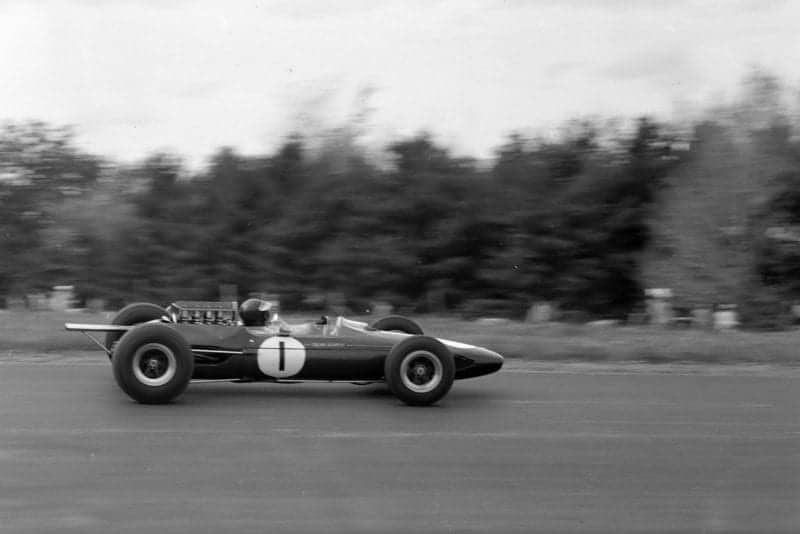
Clark decided to use his old Lotus 25
Motorsport Images
BRM were putting in a lot of laps but were unable to break 1min 14sec, Hill saying he was “slower than last year” while Ginther had his ratio changed during practice. Both Brabhams were in difficulty as far as speed was concerned. There seemed to be nothing particularly wrong except their times were down, Gurney being unable to get below 1min 14.4sec, a whole second slower than the Lotus. BRP were having a quiet time, the cars were behaving but weren’t getting below 1min 15sec. Both drivers seemed happy but said the cars were losing at least a second somewhere.
Ireland had been told practice started early in the morning, so without checking, got up and went to the circuit, to find it inhabited at that time by a few “cotton tails” and the first of the army of campers who descend on the Glen. The enlarged Walker Team were fairly happy, Siffert and Bonnier having almost equal times of 1min 14.65sec and 1min 14.60sec respectively.
The Parnell team were not quite so happy as Amon was having fuel troubles and they were not getting the best from their BRM engine, while Hailwood had a right-hand drive shaft break on the wheel side of rubber flexible drive. All through practice Bucknum was consistently bettering his times and an army of Japanese mechanics was sorting out the problems as he found them, and by the end of the day he had the very creditable time of 1min 14.9sec about half-way through the field. Practice finished sharp at 5pm and the cars were wheeled back to the technical building for preparation for the next day.
The Club had put up a prize of 120 bottles of champagne for the first driver to lap at 120mph, a time of 1min 8.9sec, an improvement similar to those made in other types of racing which have taken place here since the track was re-surfaced. The reason for the seeming lack of improvement in the F1 field was that the new 13in tyres being used here for the first time slowed the cars on the straights due to the increased section in contact with the road, and with an improved surface adhesion this held maximum speeds down even more.
The first practice had been cool, cloudy and windy, but Saturday was brilliant, warm without being too hot, with a light breeze. G Hill and Ginther were out as soon as practice started to try certain minor modifications which, in fact, improved their times by half a second. Parnell’s trouble on Amon’s car turned out to be a fuel pipe in the trap tank which had broken, so restricting the flow of fuel. P Hill’s Cooper was still in trouble with a very dead engine, and although Lucas engineers and Climax and Cooper engineers worked all day on the fuel system the engine didn’t improve and sounded horrible. In the end all concerned suggested just throwing it away!
The excitement on this second day was the four-cornered fight to get pole position. Clark, G Hill, Gurney and Surtees were doing everything they could to improve their times. Clark was now able to lap consistently at under 1min 13sec without much trouble, but he tried Spence’s Lotus 33 and also did a very fast time, so much so that Chapman had the numbers changed on the two cars and set the car up for Clark. However, before he could get going properly practice finished, so he decided to keep the old car which he had used for most of practice.
Surtees used both V8 cars and the V6. To his surprise, the V6 was faster down the straights than the V8, which was just off edge compared with its Monza performance. Still his time of 1min 12.78sec was only 0.12sec slower than Clark. G Hill, who had been improving slowly, also managed to get under 13sec with a 1min 12.92sec. The only other car in the 12-second bracket was that of Gurney, who was third fastest with 1min 12.50sec, two-hundredths of a second faster than Hill.
“The excitement on this second day was the four-cornered fight to get pole position”
The Honda, which had been improving slowly, suddenly spun off on the hairpin, damaging the right front suspension as it went over a buried rubber tyre. Also damaged was the new nose cowl. Bucknum drove slowly back to the pits and telephones began to buzz to get the parts required flown in from California. The Brabhams still seemed to be unable to improve as much as their previous day’s performance, although Gurney did slip in a 1min 12.50sec amongst some slower laps. Taylor and Ireland were going smoothly with no great troubles, although a bearing in Ireland’s gearbox did go before practice finished.
Bonnier had a balance weight come off a wheel which sheared the brake pipe; this meant re-balancing and bleeding, which held his practice up for some time, but when he did get going he got ninth fastest with a time of 1min 14.07sec. So as practice ended the front row of the grid was Clark and Surtees, with Gurney and G Hill immediately behind.
Race
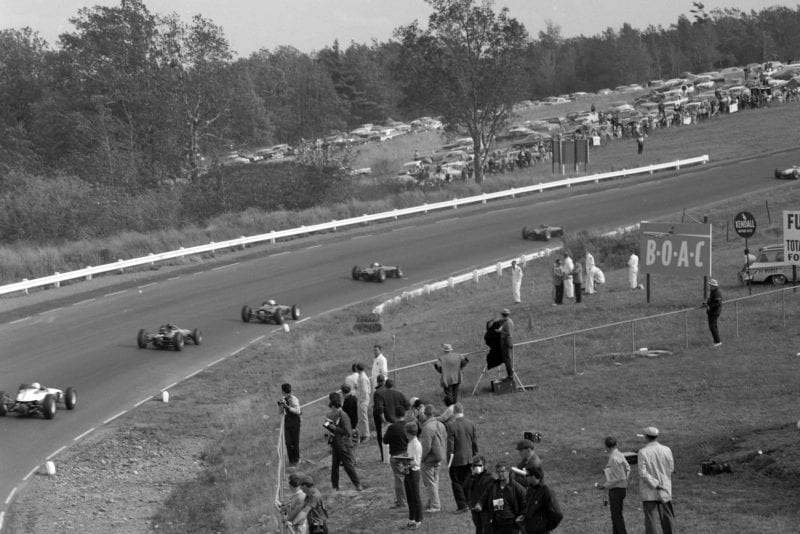
Cars stream away at the start
Motorsport Images
The overnight camping crowd was tremendous and on race morning the weather was warm and sunny with some high haze. Two hours before the start, Honda and Cooper had a short practice to ascertain whether the overnight work had been any good. The Honda had the old nose oil again, so could expect high temperatures, while Coopers had stripped the fuel supply and the electric’s, replaced the battery, and hoped to have got the bug out of P Hill’s engine. The cars lined up on the dummy grid after a warming-up lap. Surtees was driving the training cat he had used in practice.
At 2pm the cars rolled forward to the proper grid and the flag dropped. Clark shot off first but was passed by Surtees and Spence, who came through from the third row, before he reached the top of the hill. As the first lap finished Surtees led Spence, Clark, Hill and Brabham past the pits. The rest of the field swept through in the following order: Ireland, Gurney, McLaren, Bonnier, Bandini, Amon, Siffert, Bucknum. Hailwood, P Hill, Ginther, Taylor, Hansgen and Sharp.
The pace was terrific and the next two laps remained the same as far as the first four cars were concerned. Behind, however, Gurney, lying seventh on the first lap, moved past Ireland and Brabham into fifth place as he tried to make up for a poor start. Ireland completed his second lap and then went to change gear and the lever came off in his hand, having broken just below the gate, which put him out of the race after only three laps. Hansgen passed Ginther and Taylor on the second lap into 16th place, otherwise positions were unaltered.
On the fifth lap Hansgen had just passed P Hill when the Cooper died very suddenly and for no apparent reason. It was an electrical fault, either affecting the fuel injection or the ignition. Hill tried the starter several times and then gave up in disgust.
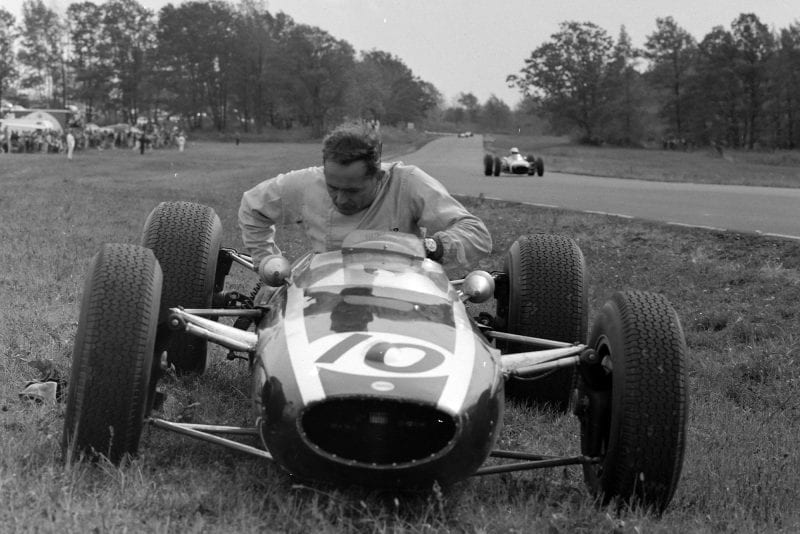
Phil Hill’s car had an electrical failure on lap 5
Motorsport Images
The lead remained unchanged for the next few laps but Hill pressed his BRM past Spence’s Lotus, and he took second place on the fifth lap. Clark, who was now getting into his stride, went past both Hill and Spence into second place. The Lotus driver had now set his sights on the leading Ferrari and in six laps reduced the short gap and got past Surtees with a piece of brilliant driving. Gurney moved ahead of Spence on the seventh lap and closed up to Hill’s BRM.
For the next eighteen laps the order of the first four remained the same, the gap between Clark and Surtees opening up considerably while the other three kept together. Behind the leaders Spence was on his own, while behind him came McLaren, who moved up one when Brabham retired on lap us with a broken piston. The next group was engaged in a nose-to-tail scrap. Bandini led Bonnier, Amon and Siffert. Hailwood was going quite well and kept ahead of the Honda, which was already boiling well. Other than the old nose, a part of the fibreglass was closing up on the air intake, which was making the car run hotter than ever.
Hansgen closed on Bucknum and passed him on lap 17, and on lap 30 he also caught and passed Hailwood’s Lotus-BRM. Ginther, who was well down, passed the Honda on the 27th lap, putting himself into 12th place. The last car, Walker’s Brabham-BRM driven by Hap Sharp, had selector trouble and he came into the pits on lap 17 and stayed for a long time, while the leaders completed another forty laps.
On the next lap McLaren came into the pits firing on seven cylinders; the plugs were changed and it was noticed that two were very wet. However, the new plugs put it back on to eight cylinders and out he went again, only to retire on lap 27 when the engine went back on to six cylinders. Bonnier began to find his car handling slightly oddly and then it lost its brakes. When it was examined in the pits the stub axle was found to be cracked, and the car was retired.
For a time it began to look as if Clark was running away from the rest of the field, and then on the 40th lap the increase in the gap was smaller instead of larger, and on lap 44 he came round in fourth place. On the next lap, the Lotus came into the pits, where it stayed while the leaders did two laps. The trouble was that the fuel injection was playing up and the car was down on power and running roughly. The three-cornered fight that had been behind Clark had been swapping places quite frequently.
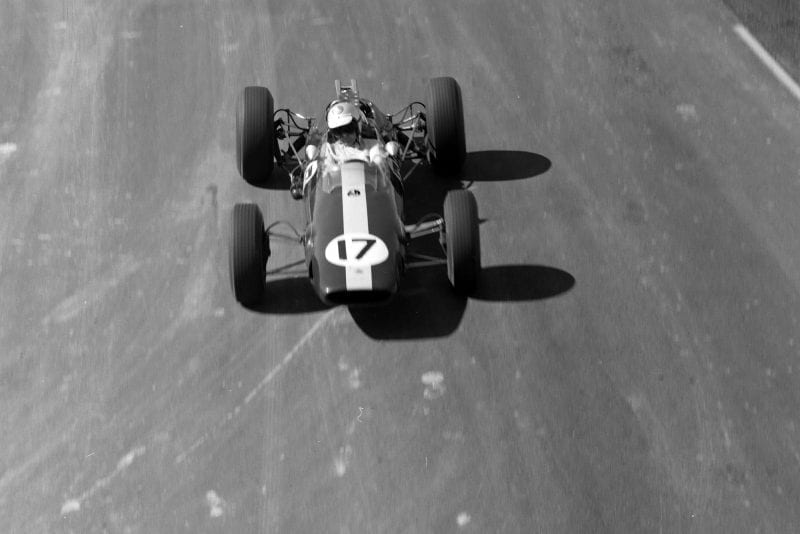
Hansgen provoked the ire of several leaders by holding them up whilst being lapped
Motorsport Images
Hansgen was a bad baulker and as he was passed by Clark, Surtees, Hill and Gurney he was soundly cursed and fists were shaken. Surtees found it so difficult getting past that Hill’s BRM had slipped past both of them before Surtees could stop him. With Clark out, Surtees led for one lap and then Hill wrested the lead from him and made sure he didn’t get to grips again. Clark went out again, now in last-but-one place, but came in again after only six laps.
While this was going on Amon had a bolt from the starter come out, which caused his engine to seize up at the top of the straight, and although he managed to stop all right he was somewhat shaken. Also at this stage, Bucknum came into the pits when his high water temperature suddenly started to drop and the engine tightened. At this stage he felt sure some plugs were out as the power was well down.
“Hansgen was a bad baulker and as he was passed by Clark, Surtees, Hill and Gurney he was soundly cursed and fists were shaken”
After examining the Clark Lotus closely, Chapman called in Spence, now lying fourth, and handed the car to Clark while Spence went out in Clark’s car, only to retire five laps later. This change of driver would not have helped Clark in his bid for Championship points, but by his superior driving it was hoped to get a good place, so pushing other contenders some points down. Bandini, who was going quite well in the flat-12, came into the pits on lap 54 and after a short while he continued for a further four laps before retiring with a “flat battery,” although one side of the exhaust was smoking badly.
With Bandini’s retirement on lap 59 things settled down a bit. The lead was firmly in Hill’s hands, while Surtees and Gurney were scrapping behind. On lap 61 Hill lapped his team-mate for the second time, and one lap later Gurney and Surtees were still trying to get past Ginther, while Hill, using his “take ten” tactics, pulled out 50 yards. Whether Surtees was cross or not will never be known, but two laps later, when passing someone else, he spun, trying to avoid the slower car when it pulled into his path.
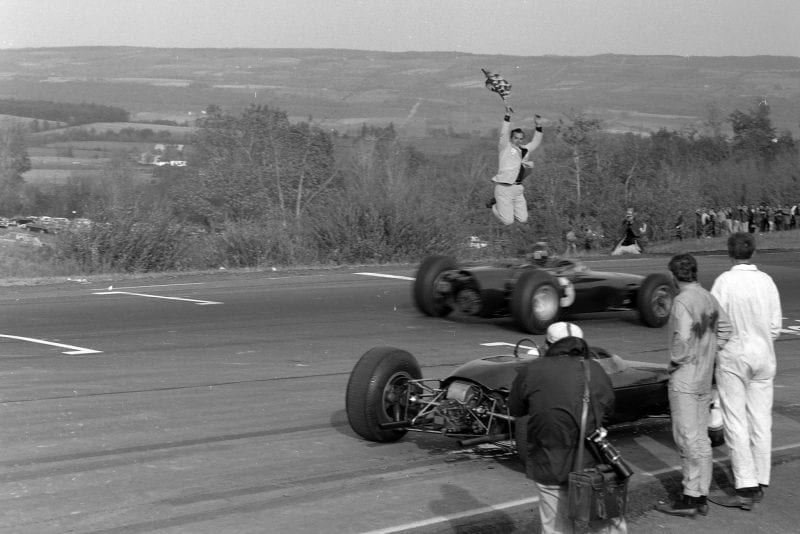
Hill takes the flag to claim victory number two of the season
Motorsport Images
Gurney’s race was soon to finish and on lap 70 he came into the pits when he noticed his oil pressure go down suddenly, and found the back of the engine covered with oil. Clark, in Spence’s car, was going quite well and lay third when a ball valve stuck and didn’t allow the fuel to pump from one tank to the other. He made a quick pit stop but nothing could be done and after a few laps he retired, although he was placed seventh, having finished more than two-thirds of the race.
Drama was not all over yet. Hailwood, who was lying fourth, pulled up suddenly before the start-finish line to coast over after the chequered flag, with oil pouring from the bottom. A pipe had broken, pumping most of the engine oil over the circuit. On the sharp corner before the pits where the oil was very bad, the normally very efficient Communications Marshals did nothing, and Bandini and Ireland ran up to put dirt into the oil, which nearly caused a “punch-up.”
Tex Hopkins, the lavender-suited starter, went through his finishing repertoire to bring an interesting race to an end. Hill and Surtees were on the same lap but that was all. Siffert, one lap behind, was third, having driven a very good race to take up positions as they fell vacant. He finished with only one gear.
There were eight cars running at the end and one of them, Hap Sharp’s, had not completed two-thirds of the race. Fastest lap went to Clark in Spence’s Lotus 33 at 1min 12.7sec (183.25kph).
